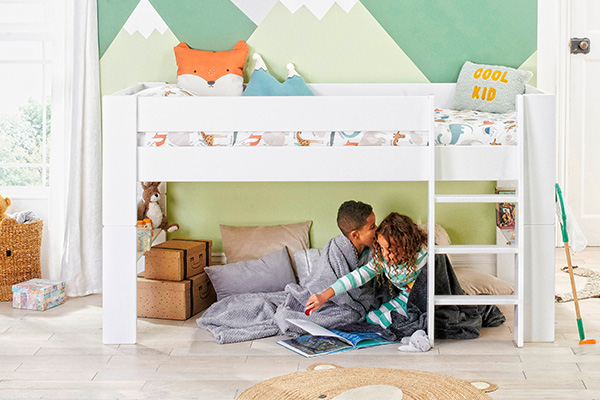Transitioning your child from a toddler bed to a midsleeper bed marks an exciting milestone in their growing independence. This step typically occurs between ages 4 and 6, when children are ready for a more mature sleeping arrangement. Choosing the right time to make this transition depends on your child’s physical development, emotional readiness, and safety considerations.
Moving to a midsleeper bed opens up new possibilities for room layout and storage solutions. These elevated beds often feature built-in desks, shelves, or play areas underneath, maximizing space in smaller bedrooms. When you’re ready to find the perfect midsleeper bed, involve your child in the selection process to build excitement and ownership.
Preparing your child for this change is crucial. Discuss the upcoming transition, emphasizing the positive aspects of their “big kid” bed. Maintain familiar bedtime routines to provide consistency and comfort during this adjustment period. With patience and positive reinforcement, most children adapt quickly to their new sleeping arrangement.
Key Takeaways
- Transition timing depends on individual child readiness and safety factors
- Midsleeper beds offer space-saving benefits and room customization options
- Maintaining consistent bedtime routines eases the adjustment to the new bed
Understanding the Transition Process
Moving from a toddler bed to a midsleeper bed marks an exciting milestone in a child’s development. This change requires careful planning and consideration to ensure a smooth transition for both parent and child.
Read more : Remedies for Managing Depression Symptoms
Recognizing the Right Time to Transition
Most children are ready to move from a toddler bed to a midsleeper between ages 4 and 6. Signs of readiness include:
- Outgrowing the toddler bed physically
- Expressing interest in a “big kid” bed
- Climbing out of the toddler bed frequently
- Showing increased independence in daily activities
Parents should assess their child’s maturity and ability to safely navigate a higher bed. Some children may need more time in a toddler bed to feel secure.
Preparing Your Child for the Change
Involving the child in the transition process can reduce anxiety and increase excitement. Parents can:
- Discuss the move to a new bed positively
- Read books about transitioning to bigger beds
- Allow the child to choose bedding or decorations
- Practice climbing up and down safely during daytime
Gradually introducing the concept helps children adjust mentally. Maintaining consistent bedtime routines provides comfort during this change.
Choosing the Right Midsleeper Bed
Selecting an appropriate midsleeper bed is crucial for safety and comfort. Consider:
- Height: Ensure it’s not too high for the child to climb safely
- Guardrails: Look for sturdy, securely attached rails to prevent falls
- Ladder design: Choose easy-to-grip rungs for climbing
- Mattress fit: Select a mattress that fits snugly without gaps
Some midsleeper beds offer additional features like built-in desks or storage, which can make the transition more appealing to children. Always prioritize safety over extra features.
Implementing the Transition
Moving from a toddler bed to a midsleeper requires careful planning and patience. The process involves establishing routines, using effective sleep training techniques, and ensuring the new bed is safe and comfortable.
Establishing a Bedtime Routine
Consistency is key when transitioning to a midsleeper bed. Start by setting a regular bedtime and creating a calming routine. This might include a warm bath, reading stories, or gentle music.
Keep the routine short, around 30 minutes, to prevent stalling tactics. Use a visual chart with pictures to help your child understand the steps.
Gradually move bedtime earlier if needed, in 15-minute increments over several days. This helps adjust their internal clock to the new sleep schedule.
Consider using a special nightlight or comfort object to make the new bed feel familiar and cozy.
Sleep Training Techniques and Tips
Positive reinforcement is crucial during this transition. Praise your child for staying in bed and use a reward system for successful nights.
The “silent return” method can be effective. Calmly lead your child back to bed without engaging in conversation if they get up.
Try the “bedtime pass” technique. Give your child one pass per night to leave the bed for a brief, predetermined reason.
Use a toddler clock that changes color when it’s time to wake up. This helps children understand when to stay in bed.
Be patient and consistent. It may take 1-2 weeks for your child to fully adjust to the new sleep arrangement.
Ensuring Safety and Comfort in the New Bed
Install bed rails on both sides of the midsleeper to prevent falls. Make sure they’re securely attached and the right height for your child.
Place soft rugs or cushions on the floor around the bed as an extra precaution.
Choose breathable, comfortable bedding suitable for your child’s age. Consider using a sleep sack for added warmth and security.
Keep the climbing ladder or steps clear of toys and obstacles to prevent tripping hazards.
Ensure the room temperature is comfortable, typically between 68-72°F (20-22°C). Use a fan or blackout curtains if needed to create an ideal sleep environment.
Conclusion
Moving from a toddler bed to a midsleeper bed marks an exciting milestone in a child’s development. This transition offers opportunities for increased independence and creativity in room design. With proper preparation, safety measures, and a positive approach, parents can help their children embrace this change. A successful move to a midsleeper bed sets the stage for better sleep habits and a more mature sleeping environment.
